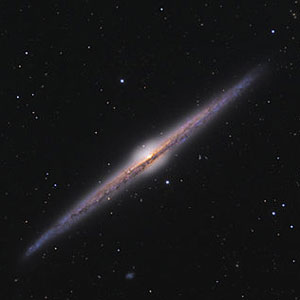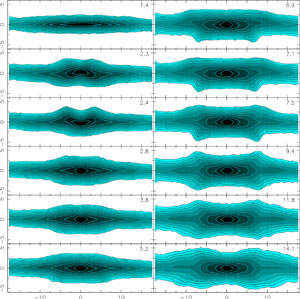The presence of stars just 100 million years old in the Milky Way Galaxy’s central regions confirms our galaxy’s nonviolent past.

Ken Crawford
If we could peer through all the dust and gas shrouding the Milky Way’s center, we’d find an oddly tasty sight: a Twinkie-shaped bulge. Like your typical Twinkie, the contents are fairly old (ok, the stars in the galactic bulge are a little older than the sweet cake, by 8 billion years or so). And like a Twinkie, it turns out, our galaxy’s bulge contains a surprising cream filling: a thin plane of very young stars.
István Dékány (Pontifical Catholic University of Chile) and colleagues found the plane when they discovered 35 Cepheid variable stars, each no older than 100 million years. The team will report the discovery in Astrophysical Journal Letters.
Making Henrietta Proud
When Henrietta Leavitt discovered in 1912 that Cepheid stars pulsate with a beat directly related to their intrinsic brightness, she gave astronomers an invaluable tool: a distance measure. By watching a Cepheid’s brightness vary and comparing the variations’ timing to the star’s apparent brightness, astronomers use these stars to measure distances to stars far outside our galaxy.
Recently, Dékány’s team turned the power of Cepheids toward a problem closer to home: the hidden depths of our galaxy. Crowded with stars, gas, and dust, the central region of our pancake-shaped galaxy is hard to puzzle out in visible light. So the VISTA Variables in Vía Láctea (VVV) team, using the VISTA telescope in Chile, peers in infrared through the mist to look for Cepheid variables pulsing.
Poring over four years of VVV data, Dékány and colleagues analyzed the light curves of 100 million point sources, 30,000 of which varied in some way. Of these, 655 stars displayed Cepheid-type variations.
But there are two types of Cepheids: Type I Cepheids tip the scale at between 4 and 20 times the mass of the Sun, and shine with luminosities up to 100,000 times the Sun’s; Type II’s are relative lightweights, typically half the Sun’s mass and much older than their cousins.
And in the Milky Way bulge, the ancient lightweights dominate. Once Dékány’s team finished sorting through the data, eliminating Type II’s by comparing their colors and luminosities, they were left with a total of 35 Type I Cepheids, each star less than 100 million years old. These are the youngest stars found in the Milky Way’s bulge, outside of the nuclear star cluster surrounding the supermassive black hole.
Interestingly, these Cepheids live in only a restricted region of the sky. They form a very thin disk with a typical height only 70 light-years tall that penetrates the bulge to span the entire galactic plane. “We think that this is essentially a smooth inner continuation of the thin disk that has been known to surround the inner Galaxy,” Dékány says.
“I think Miss Leavitt would be rather proud that her stars were used in this fashion to infer something fascinating about the galactic center region,” says study coauthor Daniel Majaess (Saint Mary’s University and Mount Saint Vincent University, Canada).
Cosmological Expectations

Martinez-Valpuesta & others, Astrophysical Journal 2006
So in other words, deep within the aging bulge, some process is forming brand-new stars. That’s not actually surprising, says Melissa Ness (Max Planck Institute for Astronomy, Germany) — if the bulge isn’t as separate a component as was once thought.
Some simulations suggest that the galaxy started out as a disk and formed its bulge when instabilities wracked the galactic plane and threw disk stars onto skewed orbits. If that’s the case, the bulge stars actually come from the disk. “That the stars in the bulge are mostly old just reflects that these stars are stars of the disk that formed a long time ago,” says Ness, “but this certainly does not prohibit new star formation.”
Paola Di Matteo (Observatory of Paris, France) adds that the discovery of young stars in the galactic midplane is yet another indication that galaxy mergers played little role in shaping the Milky Way's bulge: “This is another strong indication of the fact that our bulge has been mainly, if not entirely, formed via disk evolution and instabilities.”
 0
0









Comments
You must be logged in to post a comment.